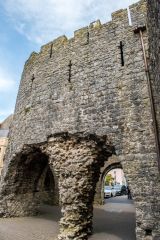
The medieval town walls of Tenby are some of the best-preserved and most historically important town walls in the UK. The walls are listed Grade I as 'one of the most important surviving medieval city walls in Britain'.
History
The walls were probably begun by the Marshall family, Earls of Pembroke until 1245, but in a sense, the walls we see today really owe their impressive strength to an attack on Tenby by Llewelyn ap Gruffydd in 1260.
Prince Llewelyn, as he is sometimes known, had little difficulty capturing Tenby and destroying much of the town. It was obvious to the Earls of Pembroke that the 13th-century walls were inadequate to protect the town.
William de Valence, who became Earl of Pembroke in 1264, rebuilt the town walls in impressive style, enclosing the entire settlement by a formidable wall defended by strategically placed towers. The wall was pierced by four gates to control access.
Maintaining such an important feature as the town wall was a problem. In 1328 Edward II helped the townsfolk by granting Tenby the right to levy a tax on goods entering the town for a period of 7 years. Money raised from the tax was to be used to maintain the wall but also to complete construction of the wall and the town quay - which obviously suggests that the wall was not yet finished.

The extra money allowed Tenby's burgesses to build more towers to defend the curtain wall. They also raised enough to build the wall's most impressive feature; an outer Barbican tower controlling access to the West Gate. This outer Barbican tower is pierced by five rounded archways, giving rise to its popular name of 'Five Arches'.
The wall fell into disrepair during the late 14th and early 15th century. In 1457 Jasper Tudor, Duke of Bedford, ordered the Mayor and burgesses to repair the walls. Perhaps just as important, he made the Mayor and burgesses fully responsible for wall maintenance and for the defence of the town. The walls were no longer the direct responsibility of the Earls of Pembroke.
As a result, the lower sections of the walls were strengthened - with a thickness of up to 6 feet in places - and the entire wall was raised by 5 feet. A parapet walk was added in several places to enable guards to keep watch.
On the landward side a 30-foot-wide ditch, or moat, was dug outside the wall for additional protection. South of the West Gate, the wall was strengthened and two large gates inserted. The walls were last strengthened in 1588 when the threat of the Spanish Armada loomed.
As the need for a defensive wall lessened over the centuries parts of the medieval structure were removed. Parts of the North Gate (also known as the Great Gate) were pulled down by 1706 and the rest was taken down in 1781 because it was a public nuisance. The South Gate was removed in 1797 and Quay Gate in 1811, leaving only the West Gate, defended by the Five Arches.
The walls are pierced by arrow slits and a crenellated parapet runs along the top.

Where to See the Walls
The best-preserved section of the town wall is between South Parade and South Florence Parade. There is also a very well-preserved albeit short section from the corner of White Lion Street to Upper Frog Street. Another fragment survives behind York House on Lower Frog Street. Easily the most impressive feature is the Five Arches but the other
Six towers survive out of an original 24. There is a semi-circular bastion halfway along South Parade, and another at the south end of the Parade. There is a square tower on St Florence Parade, a semi-circular bastion beside the Imperial Hotel, and a square tower on the edge of the cliffs.
The walls and towers on South Parade are easy to reach from the harbour. Parking is always an issue in Tenby but there are several pay and display parking areas on South Parade and nearby streets.
About Tenby Medieval Town Walls
Address: South Parade,
Tenby,
Pembrokeshire,
Wales
Attraction Type: Historic Building - Town Wall
Location: The best section of town walls stretches from White Lion Street along South Parade to St Florence Parade. The nearest post code is SA70 7JD.
Location map
OS: SN133004
Photo Credit: David Ross and Britain Express
HERITAGE
 We've 'tagged' this attraction information to help you find related historic attractions and learn more about major time periods mentioned.
We've 'tagged' this attraction information to help you find related historic attractions and learn more about major time periods mentioned.
Find other attractions tagged with:
NEARBY HISTORIC ATTRACTIONS
Heritage Rated from 1- 5 (low to exceptional) on historic interest
Tenby, St Mary's Church - 0 miles (Historic Church) ![]()
Tudor Merchant's House - 0.1 miles (Historic House) ![]()
Tenby Castle - 0.2 miles (Castle) ![]()
Tenby Museum & Art Gallery - 0.3 miles (Museum) ![]()
Penally, St Nicholas & St Teilo Church - 1.3 miles (Historic Church) ![]()
Carswell Medieval House - 2.2 miles (Historic Building) ![]()
Caldey Island Priory - 2.4 miles (Abbey) ![]()
Caldey Island, St David's Church - 2.5 miles (Historic Church) ![]()
Nearest Holiday Cottages to Tenby Medieval Town Walls:
More self catering near Tenby Medieval Town Walls










